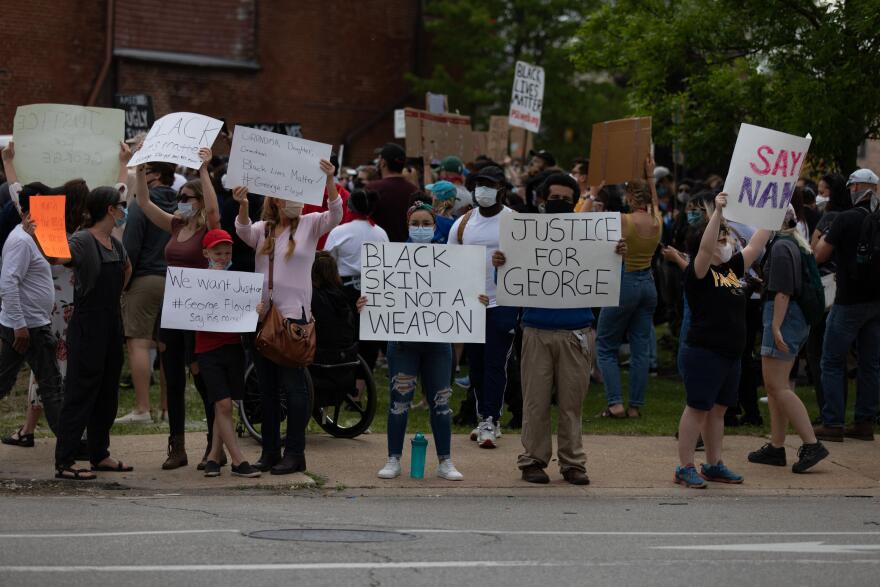Much of the news of 2020 was dominated by two major stories: the coronavirus pandemic and nationwide protests against police brutality that were accompanied by calls for immediate police reform.
Here’s how some of those stories unfolded in Wisconsin.
At one point, Milwaukee County had the most cases of coronavirus infection in Wisconsin, and it was clear who was bearing the brunt of the impact — Milwaukee’s Black communities. County data showed that the majority of cases early on were concentrated on the north side of the city.
Gov. Tony Evers called it “a crisis within a crisis.”
But Black health professionals in Milwaukee said in April they weren’t surprised. They said COVID-19 exposed disparities that had been prevalent for generations; disparities that stem from being economically and environmentally disadvantaged.
READ: Wisconsin's COVID-19 Death Disparity Is 3rd Worst In America. Is Segregation To Blame?
"Illnesses like this, they attack people who are not physically well and may be getting around fine but are not physically well... And so, when you look at the data in terms of who lives on the north side of Milwaukee they’re prominently African America and they’re prominatly poor. And given the circumstances to try to get a job or trying to do whatever that remains a problem," said Dr. Patricia McManus of the Black Health Coalition of Wisconsin, Inc.
Soon after the coronavirus hit the Black population hard, there was a surge in cases among Latinos on Milwaukee’s south side.
The toll that COVID-19 took among Black and Latino people called attention to inequities in health outcomes. At the same time, broader questions about race and social justice were emerging — centering often on police treatment of people of color.
Last February, a Black teen, Alvin Cole, was shot and killed by a Wauwatosa police officer, Joseph Mensah. Cole was armed with a gun, and the officer said he heard a shot and was acting in self-defense. Cole was the third person of color the Black officer killed in the line of duty.
In April, Joel Acevedo, who was Latino, died after Michael Mattioli, a white, off-duty Milwaukee police officer, put him in a chokehold after a party.
Protests over the deaths of Cole and Acevedo became part of cries of Black Lives Matter after the May 25 police killing of George Floyd in Minneapolis.

Across the country, people demanded police reform. In one of many local demonstrations, hundreds protested at the District One Police Station in downtown Milwaukee in June.
One man with a bull horn led a call and response chant with the crowd. He yelled: “I can’t breathe. Can you breathe?" Then the crowd yelled back: "I can’t breathe!"
Protests sprung up in a number of cities and Milwaukee marchers gathered daily, with some of them walking to Washington, D.C.in August to participate in the anniversary of Dr. Martin Luther King, Jr.’s “I Have a Dream” speech.
Cries for justice only grew louder when on Aug. 23 Rusten Sheskey, a white Kenosha police officer, fired seven shots toward Jacob Blake’s back. Blake, a Black man, was paralyzed from the waist down.

His neighbors, a married couple, Tamika & Donnell, were with Blake moments before the shooting.
Tamika said such incidents make her fear for her family.
"With me being a mother of three Black sons, like it’s scary. Cause, how they supposed to live they life? In fear? Like, they ain’t supposed to just be in fear. They supposed to be able to live they life comfortably like everybody else. And it’s terrible that we — us, as a Black people, we can’t," she said.
Demonstrations erupted where Blake was shot, and protesters marched in the streets to the Kenosha County Courthouse. On the way, they chanted: "What do we want? Justice! When do we want it? Now! If we don’t get it, shut it down!"
Nights of unrest followed in Kenosha and Gov. Evers deployed the National Guard. Protestors were tear gassed, businesses were vandalized, and garbage trucks were set on fire.
Two nights into the unrest, a white teen, Kyle Rittenhouse, shot 3 protesters, killing two of them. The 17-year-old Illinois resident was ordered to stand trial and will be arraigned in early January.

The Kenosha County district attorney has not decided yet whether to charge Officer Sheskey in the shooting of Blake.
Protests continued into the fall, as the Milwaukee County district attorney chose not to charge Joseph Mensah in the death of Alvin Cole in Wauwatosa.
Mensah has since resigned from the Wauwatosa police department.
Michael Mattioli, the Milwaukee police officer whose chokehold killed Joel Acevedo, also resigned from his post. He has entered a not guilty plea to first degree reckless homicide charges.
As activists and others await potential developments in the courts, they’re also waiting for a restructuring of police budgets and a shift in funding to social services. Calls to defund the police have largely gone unanswered in many cases. Meanwhile, Milwaukee area marchers continue pushing for change, recently marking the 200consecutive day of protests.
Support for Race & Ethnicity reporting is provided by the Dohmen Company Foundation.

Do you have a question about race in Milwaukee that you'd like WUWM's Teran Powell to explore? Submit it below.
_






